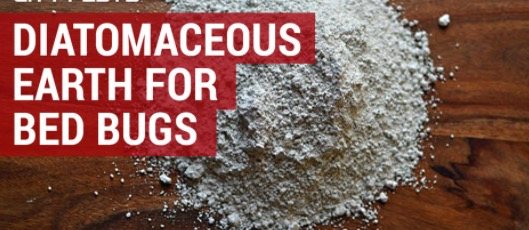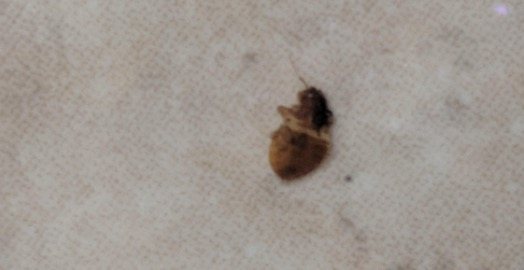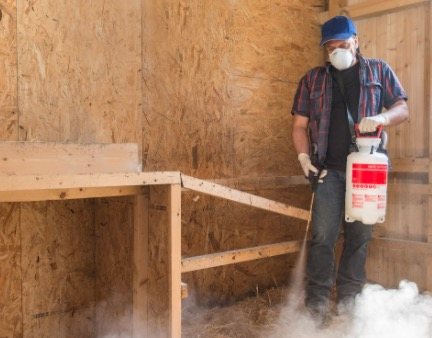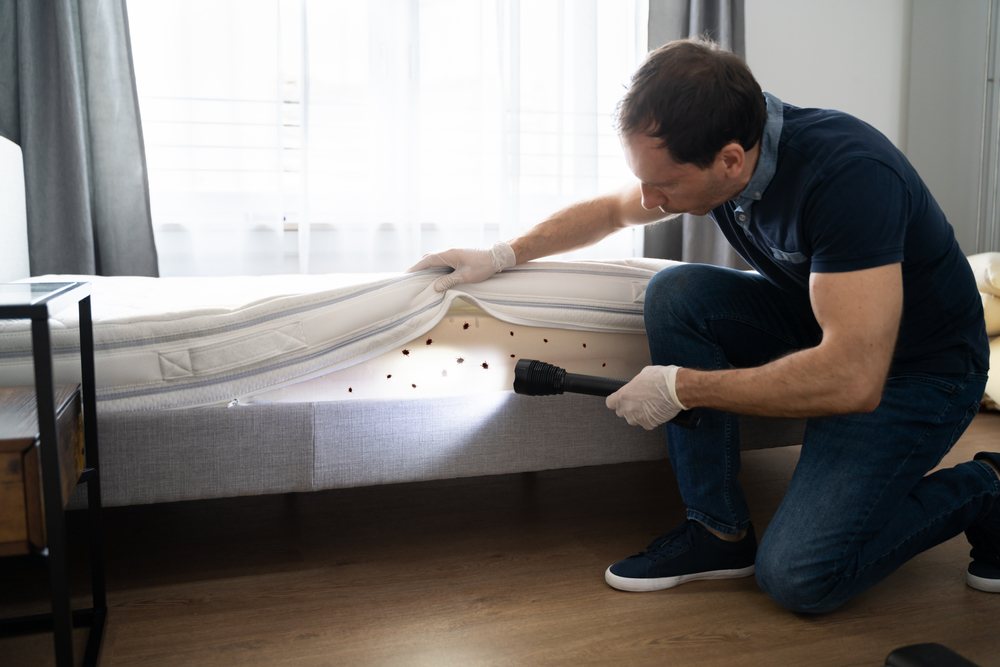Bed bugs cause problems for millions of Americans every year.
These tiny bugs feed on blood, and create homes inside mattresses and other furniture.
Getting rid of these insects is often easier said than done.
There are dozens of possible professional and DIY solutions you can try…
and diatomaceous earth is one of them.
Diatomaceous earth is a natural repellant, so it’s a much safer alternative to other potentially harmful products.

Apart from killing bed bugs, it’s also very effective against similar insects.
Such as:
- Fleas
- Roaches
- Spiders
- Beetles
The solution is made from fossilized single-cell algae that are full of silica.
Deposits are found near riverbanks where they are mined and dried. The result is a natural solution with a long-lasting effect and minimal effects on health.
Though bed bugs were largely eradicated in the mid 20th century…
Bed bug cases have been steadily rising every year. With reported cases in every state in the country.
It’s safe to say that bed bugs have made a serious comeback, and they’re not going away anytime soon.
Let’s take a more in-depth look into how diatomaceous earth can help get rid of bed bugs and other insects.
Page Contents:
Does Diatomaceous Earth Kill Bed Bugs?
The short answer here is…
YES.
But unlike many other chemical solutions, diatomaceous earth is 100% natural and safe for use.

It uses two key properties to get rid of insects.
Dehydration:
Many insects have a hard, waxy outer coat that keeps them hydrated and protected from heat.
When you spray diatomaceous earth over them, their protective layer peels off.
Instead of killing them right away, the bugs slowly dehydrate and die over time.
In a matter of 2 weeks… (if applied correctly)
Damage to the exoskeleton:
The fossilized remains used in the production of diatomaceous earth are very sharp and jagged.
You can see this only through a microscope, but…
Those jagged edges exist and can damage the exoskeleton of these pests.

As those insects move around, they transfer the silica onto other bugs they contact.
What makes this solution so popular is the fact that it’s safe for humans.
It’s sterilized, so it should not contain any harmful bacteria that could affect your health.
That’s why diatomaceous earth is a widely used additive when storing livestock feed and grain.
How Do You Use Diatomaceous Earth to Kill Bed Bugs?
Diatomaceous earth is a powdery substance that can be used in a few different ways.
Since it’s not in a liquid form, you have to spray it over all areas that could be affected.
So bed bugs don’t have anywhere to hide.
There are 3 methods you can try:
- Using a powder duster
- Applying it with a flat paint brush
- Wet application
Let’s dive into how to go about these solutions:
Powder Duster:
Using a Powder Duster is by far the most common way of applying diatomaceous earth.
Just load the powder into your duster’s tank, and press on the chamber to distribute the powder evenly over the entire area.

You can control the spray of the duster and pour a high-concentration of the powder directly over the bugs.
You can repeat the process every 3 days to get the maximum effect.
You can buy powder dusters through Home Depot or Walmart.
However, if you want to buy a powder duster..
Flat Paintbrush:
It’s not ideal for treating large areas, but it’s great to get those bed bugs hiding in cracks and crevices around your bed.
Using a paintbrush will also allow you to use Diatomaceous Earth more sparingly.
It’s always a good idea to try treating your bed with a paintbrush before you try a duster…
Because it can lead to a more targeted application.
Just make sure that you treat the entire area with a thin layer of dust, so the bed bugs can’t escape the powder.

Lastly, if the dry application didn’t get the job done…
Wet Application:
Just mix the diatomaceous earth with water at a ratio of 1:4.
And spray it over your bed with any type of sprayer.
Since the powder has to dry out to work:
This method should be used only for areas that are impossible to treat with the previous techniques.
The below video provides an in depth look on how to apply DE effectively.
How Long Does Diatomaceous Earth Take to Work on Bed Bugs?
As said previously, diatomaceous earth is not an instant insect killer.
Instead…
It sticks on the insects and damages their outer shell, which leads to dehydration and, ultimately – death.
Those effects need anywhere between:
5 and 17 days to become visible.
But once your bed is treated properly, hopefully these pests don’t return.
If you’re experiencing recurrences of bed bugs after application, you may need to utilize a professional treatment option.
A more powerful method of bed bug removal is a professional bed bug heat treatment.
How Long to Leave Diatomaceous Earth on Carpets
Diatomaceous earth is effective against many insects, including fleas.
If you have an indoor pet, it can ensure that there are no flea colonies hiding in your carpets or furniture.

(Click here to learn about the effects of bed bugs on pets).
After that, apply the dust carefully around the carpet edges…
To keep insects from walking onto it.
Then, get a broom or a piece of cloth and rub the powder firmly into the carpet to expose as many bugs as possible.
Since the bugs die slowly, you need to leave it on the carpet for at least a week.
If you can…
Take the carpet into your garage or a room that you don’t use that often, and wait until all insects die.
When your carpet is finally free of bed bugs, remove the DE with a filterless vacuum.
DE can’t damage your carpet.
So you can leave it on there for months if desired.
Consider leaving some of this product under the carpet edges as a preventative measure.
Where to Buy Diatomaceous Earth
DE is widely used by the following professions:
- Gardeners
- Farmers
- Botanists
- pool caretakers
- pest control specialists
So it’s available in most gardening hardware stores.
You can also find some DE products in Walmart and other similar stores all over the United States.

Furthermore, there are dozens of online stores with gardening equipment, and DE is one of those products you can find in any of them.
Since it provides all kinds of benefits and a wide range of applications
(both indoors and outdoors)
This product isn’t too hard to find.
Here are some reputable places to by Diatomaceous Earth:
Can I Put Diatomaceous Earth on My Bed?
Since DE is 100% natural and safe for humans as well as animals, there’s no reason why you couldn’t put it on your bed.
However, it’s a powdery substance that could transfer to your clothes and skin.
(Causing irritation)
You also don’t want DE floating around the air because:
It can cause damage to your lungs if inhaled.
Another thing to keep in mind is that DE needs a few days to kill all bed bugs, so you should sleep elsewhere.
Just until it’s clear the surrounding bed bugs are dead.

Then vacuum the bed to remove the leftover powder, and remove any dead bugs from your bedding and mattress.
Borax vs. Diatomaceous Earth
Borax is a pesticide made from boric acid. It’s one of the weakest pesticides, so it’s mostly harmless for humans.
It’s a diluted acid found in the form of crystals, rather than liquids.
Just like DE, it’s a slow-acting poison, but instead of dehydrating bed bugs…
It affects their stomach and nervous systems.
The slow-acting effects let bugs crawl back to their hiding places and die.
Other bugs will then come in contact with the poisoned bug and die a few days later.
Once the chain reaction starts…
It won’t stop until (hopefully) all bed bugs are dead.

Borax and diatomaceous earth are very similar, but there’s one major difference:
DE is 100% natural.
Even though Borax is mostly harmless to humans, it can still cause problems.
(Especially if it comes in contact with your food).
The bottom line is that DE is an eco-friendly alternative to all bed bug repellents, and it can’t harm you or your pets in any way.
Just be aware, diatomaceous earth is known to cause irritation in the respiratory systems if an individual is exposed to long-term consumption.
Either way:
It’s usually the safest substance for treating bed bugs, and it provides long-lasting effects that will keep insects away from your bedroom if applied correctly.
Can Bed Bugs Become Immune to DE?
To reiterate:
DE works by drying the bed bug out or cutting open its abdomen.
(leading to its death)
Under a microscope this powder is extremely sharp (like tiny knives).
Since DE isn’t exactly a chemical, bed bugs CAN NOT become resistant to its effects.
Though bed bugs can’t become immune, they won’t be killed unless DE is used correctly.
You shouldn’t dump this product all over a room that you think is infested…
But rather apply it directly to areas where you think bed bugs could be hiding.





As a head’s up, I’d recommend people be very careful applying DE themselves. They should make sure they have lung protection, as DE can cause silicosis and other issues: https://www.ncbi.nlm.nih.gov/pmc/articles/PMC6790245/
Also, there is evidence that bed bugs are becoming resistant to DE as well. See this excerpt from the same article: “Furthermore, evidence of tolerance to silica-based desiccant dusts has been reported in the bed bug population (Lilly et al. 2016). Considering the aforementioned irreversible problems arising from use of diatomaceous earth, the main question is, “Is diatomaceous earth a friend or foe?”. Considering hazard of diatomaceous earth to human health, the recommendations can be 1) to remove DEs after the applications, 2) to have DEs with increased particle sizes that may have reduced risks, 3) to use DEs in restricted areas that limit direct exposures, 4) to use DEs in baiting stations, etc.”